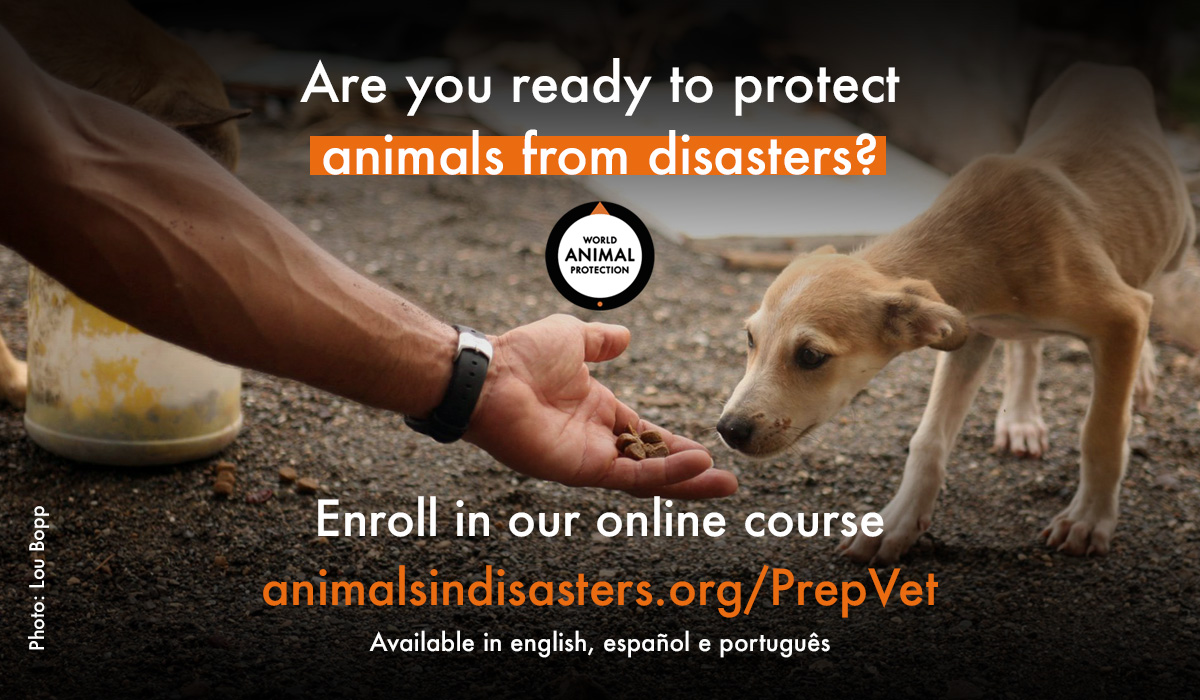World Animal Protection

“ PrepVet หรือ Veterinary Preparation” (หลักสูตรออนไลน์ฟรี)
สำหรับสัตวแพทย์และบุคคลทั่วไปที่สนใจเรียนรู้วิธีการจัดการสัตว์ในช่วงเกิดภัยพิบัติ
วัตถุประสงค์ของหลักสูตร: การจัดการและการลดความเสี่ยงรวมถึงการทำความเข้าใจปัจจัยที่นำไปสู่ภาวะฉุกเฉินและการเตรียมพร้อมสำหรับปัจจัยเหล่านี้เพื่อลดการสูญเสียสัตว์
หัวข้อหลักสูตร ได้แก่
1. การลดความเสี่ยงจากภัยพิบัติ (DRR) และการจัดการ
2. การปรับตัวต่อการเปลี่ยนแปลงสภาพภูมิอากาศ
3. การดูแลสัตว์เบื้องต้นในภาวะฉุกเฉิน
รายละเอียดหลักสูตร: https://animalsindisasters.org/prepvet
เข้าสู่ระบบหลักสูตร: http://cursosenlineabienestaranimal.org/login/index.php
วิดีโอหลักสูตร: https://animalsindisasters.org/vlog/animals-in-disasters-prepvet
PrepVet (Veterinary Preparation)
About the course
The number of natural disasters has increased significantly in recent years. This has resulted in loss of human and animal life and significant economic, social and environmental impact.
Disasters have diverse natural and man-made causes. When these factors are combined with other risks that have been building or are unresolved in risk-prone areas, there is a dramatic increase in the number of disasters.
Although many hazards are unavoidable, the vulnerability of communities can be reduced.
The objective of the PrepVet course is risk management and reduction, including understanding the factors that lead to emergencies and being prepared for them, to minimise animal losses.
Many people in risk-prone areas rely on animals for their livelihoods and survival. Therefore, protection of animals in disasters is a key focus of the strategies in this course. Protecting animals can be a means of guaranteeing the social, economic, emotional, food and environmental security of people.
The online PrepVet course is divided into three core topics:
- Disaster risk reduction (DRR) and management
- Climate change adaptation
- Basic care of animals during emergencies
The course is currently available in Spanish, in English and Portuguese.
Course contents
- Disaster risk management: Basic concepts and terminology
Presents the information needed to promote the analysis and planning of disaster risk reduction - Disaster risk reduction analysis and plans
Offers the necessary tools to analyse and prioritise risks, evaluate available resources, design strategies to address them, and implement a solution. - Companion animals
Illustrates the role of the veterinarian in the training of animal owners to include their pets in a family emergency plan. - Climate change adaptation
Identifies indicators of climate change, how it affects communities and their animals, and the adaptation actions that must be implemented to counteract its negative effects. - Safety in emergencies
Outlines the physical and emotional dangers to which an individual who is actively involved in emergency operations is exposed, as well as the measures that must be taken to avoid them. - Incident command system
Introduces the incident command system as a common organisational structure that manages the resources allocated to effectively achieve the objectives relevant to an event. - Triage
Introduces triage as a tool for prioritising individuals affected by an adverse event, to streamline patient flow and achieve more effective veterinary assistance during a disaster. - Animal evacuation process
Outlines the different actions that specialized rescue teams carry out to evacuate animals during a disaster, following basic animal welfare regulations. - Standards and guidelines for livestock interventions in emergencies: Introduction to 'LEGS'
Introduces a set of international guidelines for the design, implementation and evaluation of livestock interventions to assist people affected by a disaster. - Role of the vet
Reviews the role of the veterinarian in risk management, emphasising the promotion of proper management of the animals, their environment and resources, as well as risk mitigation strategies at the farm and clinic levels. - Animal welfare
Introduces animal welfare as an interdisciplinary, multifaceted and complex science, based on animal sentience and therefore seeks its physical and mental well-being.
Are you interested in PrepVet?
The course is available to veterinary medical schools, ministries of agriculture, civil defence and other organisations interested in training vets and other stakeholders in risk management within a disaster preparedness and care framework.
If you’re interested in offering the course, please contact us for more information using the button below. The course is free to replicate, but may have a cost for the final user, depending on the type of certification desired.
If you are an individual who wishes to take the online course online you can do so by logging on to
https://cursosenlineabienestaranimal.org/login/index.php